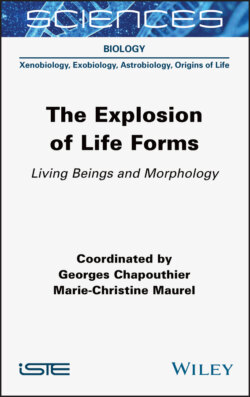Читать книгу The Explosion of Life Forms - Группа авторов - Страница 24
2.3. Exploration
ОглавлениеThere are some objections to the Darwinian definition, as life could potentially be based on other components than chemistry. There could be computer or robotic life, as Dawkins (2010) and Dennett (1996) point out. Portraying life in a mechanical way certainly has some attractivity to it in the light of the modern scientific world view. If life can be described mechanically and in a purely functional way, why could it not be based on mechanics as well? As a matter of fact, however, although we do know quite a wealth of life forms on Earth, we do not know any life based on non-organic components. So, it makes sense to me to agree with Oparin that “[l]ife is a property of any organism, from the highest to the lowest, but it does not exist in inorganic natural objects, no matter how complicated their structure” (Oparin 2010, p. 71). There might be exceptions hidden in the depths of the universe, but Oparin would define them differently than “life”. That being said, I believe him to be right insofar that we need to focus on Earth life to understand the phenomenon better, though the result could be transferable to other environments as well.
Much about science is about the fuzziness and continuous transition in nature apart from human taxonomies. Maybe “life” is a categorial description, which is hard to apply to aspects of nature which nevertheless play an important role in the emergence of the phenomenon. When “the origin and the evolution of life coincide” (Maurel 2017, p. 22) and life is physics and chemistry with a history, the small size and gradualness of historical transitions may explain the difficulty to “capture” the moment when life on Earth emerged. “If the origin of life is seen as the evolutionary transition between the non-living and the living, then it is also necessary to recognize it as a historical process shaped in part by the vagaries of contingent events. It also suggests that attempts to draw a strict line between these two worlds may be meaningless. In other words, the appearance of life on Earth should be seen as a non-progressive evolutionary continuum that seamlessly joins the prebiotic synthesis and accumulation of organic molecules in the primitive environment, with the emergence of self-sustaining, replicative chemical systems capable of undergoing Darwinian evolution (Lazcano 2017b, p. 90).
There still might have been accelerated transitions like later in the history of life (Eldredge and Gould 1972). We should avoid, however, demanding the emergence of life to be somewhat discontinuous in case we are only motivated by the desire to ascribe meaning and distinctiveness to our own status as living beings; we could be biased. Yet even if there is nothing special about organisms, this “does not mean an absence of significant differences deserving more thorough study by scientists” (Morange 2017, p. 107).
We have written about life as a natural phenomenon. We, the ones reading and writing this, are part of the picture. We are the ones defining and applying categories on nature by use of language with its subject-predicate-object structure. One could even ask “whether life can at all be described as ‘something’ common to all living beings making them living beings, whether the term ‘life’ realistically refers to an aspect of reality, or whether the term ‘life’ is only meaningful within language” (Rehmann-Sutter 2016, p. 270). Our point of view is dominated by the perspective of intelligent, conscious and speaking life for sure. Contrary to a purely constructivist approach, I would claim, however, being alive is certainly an aspect of reality as well. That it maybe cannot exactly defined or delimited does not mean it does not exist, in all the fuzziness of nature. “The recognition that life is the outcome of an evolutionary process constrained by the laws of physics and chemistry can lead to the acceptance that many properties associated with living systems, such as replication, self-assemblage or catalyses, are also found in nonliving entities. Some systems may not be ‘half-alive’ but they can exhibit some of the properties we associate with living entities” (Lazcano 2018, p. 11).
